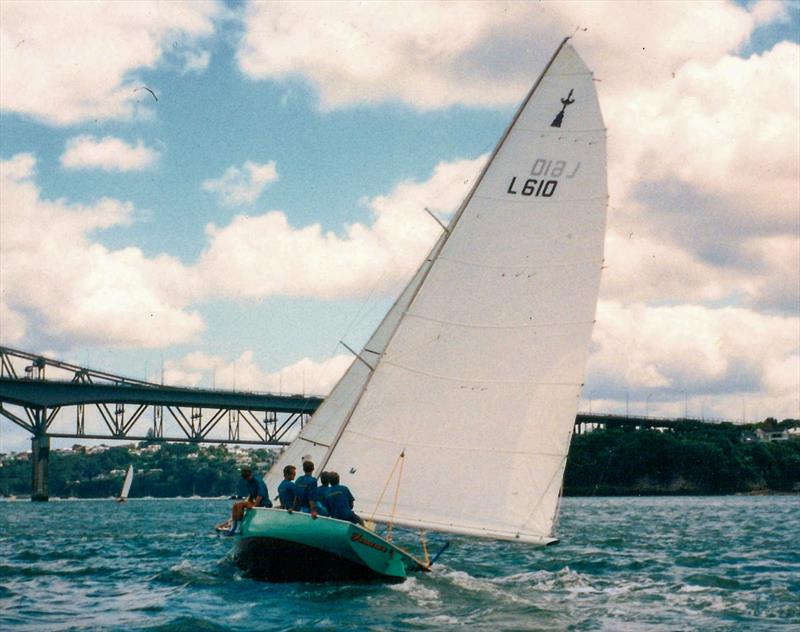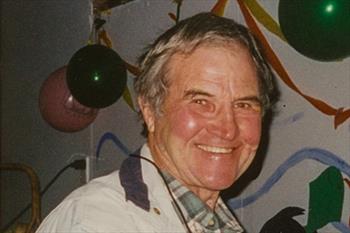
Innovative boat builder and founder of Mackay Boats leaves a remarkable legacy of achievement
by Mackay Boats/Sail-World NZ 11 Dec 16:25 PST

Jim Mackay racing his L class Tamarau in the Lipton Cup © Mackay Family archives
 Jim Mackay will be remembered for establishing a highly successful legacy in high-performance boat construction © Mackay family archives
Jim Mackay will be remembered for establishing a highly successful legacy in high-performance boat construction © Mackay family archives
One of New Zealand’s premier boat builders, Jim Mackay, passed away in early November at age 91.
Initially recognized as a racing sailor during the 1960s, Jim was renowned for crafting wooden racing dinghies, first for the singlehanded Olympic Finn class and subsequently for the two-man Olympic Flying Dutchman class, utilizing cold-moulded veneer techniques.
Jim Mackay was among the first in New Zealand to produce series of wooden boats, including a batch of ten for the 1977 OK Dinghy Worlds in Takapuna, New Zealand.
He founded Mackay Boats, now acknowledged as a leading global builder in Olympic and high-performance classes, achieving 36 Olympic medal wins and 152 medals at world championship level.
Two of his sons, Dave and Owen Mackay, share valuable insights into Jim’s extensive boat-building endeavors and cherished photographs:
Born in 1933 on Auckland’s North Shore, he lived near the waters of Shoal Bay on Auckland harbor. His great-grandfather, Richard Mackay, was a prominent shipbuilder in Auckland after emigrating from Scotland in the 1860s. His father Doug was a marine engineer, and uncle Jim Mackay, along with Doug, raced mullet boats from the Ponsonby Cruising Club during the 1930s.
Jim’s passion for boating began early. As a young boy during the war years, when resources were limited, he creatively crafted canoes from corrugated iron. He would flatten the sheet of iron, fold the ends to create a bow and stern, and seal the joints with road tar. It worked! Jim was out boating.
During his teenage years, Jim immersed himself in racing yachts, including P class, Z class, and Idle-alongs, sailing from the Takapuna Boating Club in Bayswater. He represented Auckland in the Tanner Cup for P Class and in the Cornwall Cup in Zeddies.
He left school at 16 to begin an apprenticeship in boatbuilding at Chas Bailey on the Auckland waterfront. Before long, he started building boats for himself and others in his parents’ garage on Eversleigh Rd.
Jim married Mavis in 1958 and had four sons: David, Owen, Stuart, and Sheridan. Boatbuilding moved to the back room of their home on Calliope Rd in Devonport, where he crafted the first Finns in preparation for the 1960 Olympics in Rome, securing national titles for Peter Spencer and Ralph Roberts in Jim’s boats.
Jim built boats that fueled his passion. In the 1960s, he raced Flying Dutchmen and constructed boats for many competitors. The class in NZ flourished with close racing and continuous development, culminating in Jim and Bob Wilkinson winning the 1964 Nationals, and Helmer Pedersen and Earle Wells winning Olympic Gold in Tokyo. This illustrated the power of collective energy in close racing.
The predominant boatbuilding method of the time involved cold-moulded timber made from multiple layers of veneer or thin planks glued over a wooden mould. Occasionally, fore and aft stringers were included in the hull molding process, especially for keelboats, mullet boats, and surfboats. However, for racing dinghies, the hull often emerged from the mould merely as a timber skin, with frames and stringers added later, allowing adjustment to meet design specifications.
In 1963, Jim relocated his growing boatbuilding business to a factory on Sunnybrae Rd in Glenfield, close to the family’s new residence. He diligently worked to support his family while exploring surfboats, launches, keelboats, and racing powerboats, alongside continuing to build FDs, Finns, OK Dinghies, 18-footers, Contenders, and Solings.
Jim built and raced 18-footers in the class’s early days, requiring four crew members on the wire to harness their power. He later constructed the state-of-the-art Bruce Farr-designed Travelodge for Terry and Kim McDell, with which they, alongside Peter Brooke, clinched the 1974 JJ Giltinan Trophy in Auckland, winning with a race to spare.
Jim’s innovative spirit truly emerged in the 1970s when he began racing powerboats. He quickly realized that offshore powerboats needed a specific rocker curve and deep V design to minimize wetted area and enhance control in rough seas. He pioneered a construction method involving robust internal girders bonded to the hull with heavy epoxy glass laminate. His boats were built for performance, winning five consecutive North Island driver’s championships, including seven victories in nine races that season with Richard Mitri aboard his own boat.
Owen Mackay has restored one of those boats and continues to compete with it in the North Island circuit.
Surf boats and surf canoes remained the backbone of Jim’s boatbuilding enterprise throughout his career. He cherished the sport’s athleticism and joined Muriwai SLSC, rowing in one of their boat crews. The boats, made from triple-skin veneer, required thousands of staples to be removed between layers. Many family members recall having blisters from pulling staples at the factory. Jim and Mavis spent a few years in Australia during the late ’80s and early ’90s, where they built surfboats for Australian surf clubs on a friend’s farm.
In the late ’90s, Jim decided to return to sailing mullet boats, a family tradition. He acquired Tamatea and enlisted his sons and a few others as crew. Although they didn’t win their first Lipton Cup, Jim and Mavis soon started constructing a new mullet boat, which he named Tamarau, meaning “four sons.” Jim and the team achieved victory in the Lipton Cup in 2000 with this fast and innovative vessel, and Jim won it an additional six times over the following years with several of Auckland’s prominent sailors aboard Tamarau.
Jim left behind a legacy of a lifetime spent in boatbuilding.
The skills and knowledge he imparted to his sons live on at Mackay Boats today, resulting in an impressive record of 36 Olympic medals and 152 World Championship medals.
Jim Mackay’s legacy of achievement is poised to continue in January at the 2024 Int Moth Worlds, where Bieker Moths from Mackay Boats finished second overall, boasting seven competitors in the top ten. Mackays secured six of the top spots overall in the 2021 Int Moth Worlds.